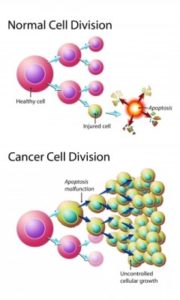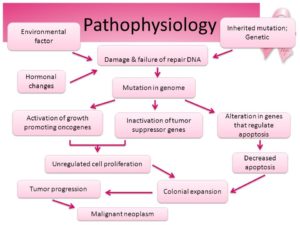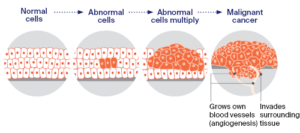
Table of Contents
What is Cancer?
- Simply understanding, cancer is an abnormal growth of body cells.
- Cancer is characterized by a cellular malfunction.
- One defining feature of cancer is the rapid development of abnormal cells that divide uncontrollably beyond their usual boundaries.
- Cancer is a malignant condition in which the spread of abnormal cellular growth could become uncontrollable.
- These abnormally growing cells can invade adjoining parts of the body and also spread to other organs. This process is known as
- During cancer, a group of cells starts multiplying in an uncontrolled or haphazard way, forming lumps or tumors.
- Cancer is a generic term used for a large number of diseases that can affect any part of the body.
- Cancer can start almost anywhere in the human body, which is made up of trillions of cells.
- In cancer, the cells grow abnormally.
- In a normal condition, cells divide in a controlled manner to replace old or damaged cells in need but if the cells keep on dividing even when not needed, it forms a mass of tissue called a ‘tumor’.
Note: Some types of cancer do not form a tumor. These include blood cancer (leukemias), most types of lymphoma, and myeloma.
- However, not all tumors are cancerous. A tumor may or may not develop into cancer.
- The tumors can be cancerous or non- cancerous.
- In medical science, a tumor is called a neoplasm. When a neoplasm is malignant, it is called cancer.
Is Tumor a Cancer?
- Not all tumors are cancerous.
- There are two types of tumors; benign tumor and malignant tumor.
- In case of benign tumors, growth is limited to certain part of the body.
- A tumor becomes cancer when it is malignant e., grows uncontrollably and spreads locally or to distant sites.
Key Facts on Cancer
- Cancer is a second leading cause of death worldwide, accounting for nearly 10 million deaths in 2020, or nearly one in six deaths.
- The most common cancers are breast, lung, colon and rectum and prostate cancers.
- Breast cancer is most common cancer among female and lung cancer among male around the globe
- Tobacco use, high body mass index, alcohol consumption, and lack of physical activity results in around 1/3rd of deaths from cancer.
- Cancer-causing infections, such as human papillomavirus (HPV) and hepatitis, are responsible for approximately 30% of cancer cases in low- and lower-middle-income countries.
- Early detection and effective treatments can cure many cancers
Some Myths and Misconception About Cancer
- Eating too much sugar or artificial sweeteners causes cancer
- Cancer is always fatal and contagious
- Radiation therapy will kill us
- No history of cancer in the family means no cancer
- All lumps are cancer
- Cancer surgery leads to its more spread
- Hair will never regrow after chemo
- Cellphones causes cancer
- Your attitude determines the outcome of the treatment
Different types of cancer
1. According to the organ affected
Broadly categorizing, there are 19 types of cancer related to our lifestyle:
| 1. Breast cancer | 2. Cervical cancer |
| 3. Oral cancer | 4. Cancer of the bladder |
| 5. Cancer in the eyes | 6. Cancer of the pancreas |
| 7. Colorectal cancer | 8. Esophageal cancer |
| 9. Kidney cancer | 10. Laryngeal cancer |
| 11. Liver cancer | 12. Lung cancer |
| 13. Ovarian cancer | 14. Prostate cancer |
| 15. Skin cancer | 16. Stomach cancer |
| 17. Testicular cancer | 18. Thyroid cancer |
| 19. Uterine cancer |
2. According to the point of beginning
On the basis of where it begins, cancers are divided into four types. They are:
a) Carcinoma
- Carcinoma develop in skin or epithelial cells like gastrointestinal tract or mucous membrane.
- They usually form solid tumors.
- Most common type of cancer. About 80-90% cancers are of this type.
- Examples of carcinoma include lung cancer, breast cancer etc.
b) Sarcoma
- Sarcoma begins in the connective tissues like bones, cartilage, muscles, fat and nerves
- It mainly develops painful mass on the bone
- Example: Liposarcoma, Myxosarcoma
c) Leukemia
- Leukemia is a cancer of the blood/white blood cells.
- It is the cancer of the bone marrow where the blood cells manufacture.
- Leukemia is categorized by overproduction of immature white blood cells
- Example: Myelogenous or granulocytic leukemia
d) Lymphoma
- Lymphoma is a cancer that originates in the lymphatic system/immune system
- It occurs in the glands or lymph nodes of lymphatic glands like spleen, tonsils, and thymus
- There are two major lymphoma types; Hodgkin’s lymphoma and non-Hodgkin’s lymphoma (NHL)
3. According to the type of tumors
According to the types of tumors, cancer can be divided into two types:
1. Benign tumor (non- cancerous)
- Benign tumor cannot spread or grow or they do spread very slow.
- Benign tumors are not harmful and they are unlikely to affect other parts of the body
- But they can cause pain or other problems if they press against nerves or blood vessel or trigger overproduction of hormones
- Example: adenomas which develop in glandular epithelial tissue like polyps in the colon or hepatic adenomas, fibromas that grow on connective tissue, hemangiomas that cause excessive growth of blood vessels, etc.
2. Malignant tumor (cancerous)
- Malignant tumor grows when the cells grow uncontrollably.
- Malignant tumors can grow quickly and spread to other parts of the body as metastasis
- The cells that move to the other parts of the body have ability to invade the other organs

Causes of Cancer
- Cancer starts from the transformation of normal cells into tumor cells.
- Cancer is caused by changes (mutations) to the DNA within cells.
- It results from interaction between a person’s genetic factors and three categories of external agents, including:
- Physical carcinogens like ultraviolet and ionizing radiation
- Chemical carcinogens like asbestos, components of tobacco smoke, alcohol, aflatoxin (a food contaminant), and arsenic (a drinking water contaminant); and
- Biological carcinogen like infections from certain viruses, bacteria, or parasites.
Apart from this, other factors that are associated with cancer are:
- Environmental factors like tobacco, smokes, diets, environmental pollutants etc.
- Endogenous factors like mutations change in DNA replication, metabolic reactions generating, etc.
Risk factors of Cancer
Age
- Cancer takes about a decade to develop
- It is seen mainly in older population but is can be seen at any age\
Lifestyle choice
- Smoking, drinking alcohol etc. can be driving force for cancer
Family history
- If cancer is common in family, it’s possible that mutations are being passed from one generation to the next
- Thus every generation become suspect for cancer
Health conditions
- Some chronic health conditions, such as ulcerative colitis, can markedly increase risk of developing certain cancers
Environment
- Environment contain harmful chemicals that can increase your risk of cancer
- For example: secondhand smoking, polluted air

Signs and Symptoms of Cancer
Some of the general signs and symptoms associated with cancer are:
- Fatigue
- Lump, masses or area of thickening that can be felt under the skin
- Skin changes, such as yellowing, darkening or redness of the skin, sores that won’t heal, or changes to existing moles
- Persistent changes in bowel or bladder habits
- Unexplained changes in weight, including unintended loss or gain
- Persistent cough or trouble breathing
- Difficulty swallowing
- Hoarseness
- Persistent indigestion or discomfort after eating
- Persistent, unexplained muscle or joint pain
- Persistent, unexplained fevers or night sweats
- Unexplained bleeding or bruising
Stages of Cancer
- Stage of cancer describes the size of cancer and how far it has grown.
- There are 2 main types of staging systems for cancer;
- a) TNM system
- b) Number system
a) TNM staging system
- TNM stands for Tumor, Node and Metastasis.
- T: describes the size of tumor. It can be 1, 2, 3 or 4, where 1 is small and 4 is large.
- N: describes whether there are any cancer cells in the lymph nodes. It can be between 0 (no lymph nodes containing cancer cells) and 3 (lots of lymph nodes containing cancer cells)
- M: describes whether the cancer has spread to a different part of the body. It can either be 0 (the cancer hasn’t spread) or 1 (the cancer has spread)
b) Number staging system
Number staging system uses TNM system to divide cancer into different stages.
Usually, there are 4 stages of cancer numbered from 1 to 4.
Stage 1:
- This stage basically refers that a cancer is small and contained within the organ it started.
Stage 2:
- Stage 2 usually means that tumor is larger than in stage 1 but the cancer hasn’t started to spread into the surrounding tissues.
- Sometimes stage 2 means that cancer cells have spread into lymph nodes close to the tumor. However, it depends on the particular type of cancer
Stage 3:
- Stage 3 usually means the cancer is larger.
- If a cancer is in stage 3, it may have started to spread into surrounding tissues and there are cancer cells in the lymph nodes nearby.
Stage 4:
- Stage 4 means the cancer has spread from where it started to another body organ.
- This stage of cancer is also called secondary or metastatic cancer.
Conclusion: A lower stage (such as a stage 1 or 2) means that the cancer has not spread very much. A higher number (such as a stage 3 or 4) means it has spread more. Stage 4 is the highest stage.
Preventive Measures of Cancer
Cancer can be prevented under 3 levels of prevention
1. Primary prevention
- Through avoidance of the causative agents such as cigarettes, too much radiation and chemical exposure
- Maintaining healthy body weight
- Adoption of a healthy lifestyle can be a great preventive measure
- Immunization/ vaccination against HPV and hepatitis B if you belong to a group for which vaccination is recommended;
- Avoiding exposure to ultraviolet radiation/using sun protection measures
- Ensuring safe and appropriate use of radiation in health care
- Reducing exposure to ionizing radiation
- Reducing exposure to different types of pollution
2. Secondary prevention
- It includes early detection and prompt treatment of cancer during its early stages.
- Regular examinations and screening test to detect disease in its earliest stage.
- Secondary prevention helps to reduce higher risk from cancer and save lives
3. Tertiary prevention
- Reducing the morbidity of the cancer by effective anti-tumor treatment, symptomatic treatment and rehabilitation.
Treatment of Cancer
Treatment of cancer can be done through:
- Surgery
- Chemotherapy
- Radiation therapy
- Targeted therapy
- Immunotherapy
- Hyperthermia
- Stem-cell transplant
- Photodynamic therapy
- Lasers in cancer treatment
- Blood product transfusion and donations
WHO Response to Cancer
World Health Organization (WHO) and World Health Assembly has developed plans, policies and strategies to prevent and treat cancer throughout the world.
WHO and IARC collaborate with other UN organizations, including the International Atomic Energy Agency (IAEA), and partners to:
- increase political commitment for cancer prevention and control;
- coordinate and conduct research on the causes of human cancer and the mechanisms of carcinogenesis;
- monitor the cancer burden (as part of the work of the Global Initiative on Cancer Registries);
- identify “best buys” and other cost-effective, priority strategies for cancer prevention and control;
- develop standards and tools to guide the planning and implementation of interventions for prevention, early diagnosis, screening, treatment and palliative and survivorship care for both adult and child cancers;
- strengthen health systems at national and local levels to help them improve access to cancer treatments;
- set the agenda for cancer prevention and control in the 2020 WHO Report on Cancer;
- provide global leadership as well as technical assistance to support governments and their partners build and sustain high-quality cervical cancer control programs as part of the Global Strategy to Accelerate the Elimination of Cervical Cancer;
- improve breast cancer control and reduce avoidable deaths from breast cancer, focusing on health promotion, timely diagnosis and access to care in order to accelerate coordinated implementation through the WHO Global Breast Cancer Initiative;
- support governments to improve survival for childhood cancer through directed country support, regional networks and global action as part of the WHO Global Initiative for Childhood Cancer using the Cure All approach;
- increase access to essential cancer medicines, particularly through the Global Platform for Access to Childhood Cancer Medicines; and
- provide technical assistance for rapid, effective transfer of best practice interventions to countries.
References and For More Information
https://www.cancer.gov/about-cancer/causes-prevention/risk/myths
https://www.who.int/news-room/fact-sheets/detail/cancer
https://www.mayoclinic.org/diseases-conditions/cancer/symptoms-causes/syc-20370588
https://drjockers.com/cancer-cells/
https://www.verywellhealth.com/what-does-malignant-and-benign-mean-514240
https://www.webmd.com/breast-cancer/default.htm
https://www.cancer.net/navigating-cancer-care/cancer-basics/what-cancer
https://www.cancer.net/cancer-types
https://www.cancer.org/treatment/understanding-your-diagnosis/what-is-cancer.html
https://www.cancer.org/treatment/understanding-your-diagnosis/staging.html
https://www.cancerresearchuk.org/about-cancer/what-is-cancer
https://www.cancerresearchuk.org/what-is-cancer/how-cancer-starts/types-of-cancer
https://www.cancerresearchuk.org/about-cancer/what-is-cancer/stages-of-cancer
https://www.medicalnewstoday.com/articles/323648#causes
https://www.diffen.com/difference/Cancer_vs_Tumor

